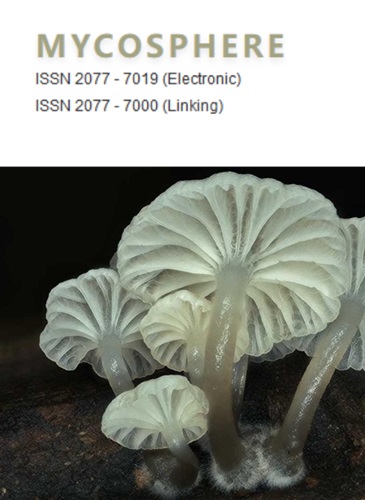Taxonomy and ecology of epifoliar fungi
IF 15.1
1区 生物学
Q1 MYCOLOGY
引用次数: 4
Abstract
Epifoliar fungi are poorly studied symbionts that co-inhabit the surface of living plants. They are relatively understudied and generally lack molecular data thus there is considerable taxonomic confusion in the group as early taxonomic studies were based on morphology. Many taxa are difficult to isolate for obtaining cultures and therefore molecular analysis is a limitation for biotrophic species unless sequenced directly from the fruiting bodies. Epifoliar fungi evolved from diverse ancestors and include mainly members of the Dothideomycetes, Eurotiomycetes, Lecanoromycetes, and Sordariomycetes. The classification of epifoliar fungi is challenging due to taxonomic confusion in historical classifications and insufficient molecular data. In this study, we provide a summary of major epifoliar families (Asterinaceae, Meliolaceae, Micropeltidaceae, Microthyriaceae, Parmulariaceae and Zeloasperisporiaceae). The modes of nutrition of each family are also reviewed. Character analysis of a combined LSU, SSU and rpb2 dataset shows that epifoliar fungi have different taxonomic and evolutionary relationships in Ascomycota. Epifoliar fungi are generally considered to be host-specific, but this needs to be confirmed using molecular data as morphological differences are minor. Therefore, future research should focus on addressing the drawbacks of current studies and use new molecular approaches. To obtain better insights into epifoliar fungi, a combination of taxonomic and ecological studies is needed.叶面真菌的分类与生态学
外叶面真菌是共同栖息在活植物表面的共生体,研究很少。它们的研究相对不足,通常缺乏分子数据,因此由于早期的分类研究是基于形态学的,因此在类群中存在相当大的分类混乱。许多分类群难以分离以获得培养物,因此,除非直接从子实体中测序,否则对生物营养物种进行分子分析是一个限制。外叶面真菌从不同的祖先进化而来,主要包括dothideomycates、eurotiomycates、lecanoromycates和sordariomycates。由于历史分类的混乱和分子数据的不足,表叶面真菌的分类具有挑战性。本文综述了主要的表叶科植物(Asterinaceae, Meliolaceae, Micropeltidaceae, Microthyriaceae, Parmulariaceae和Zeloasperisporiaceae)。并对各家庭的营养模式进行了综述。LSU、SSU和rpb2组合数据的特征分析表明,子囊菌门中表皮真菌具有不同的分类和进化关系。外叶面真菌通常被认为是宿主特异性的,但这需要用分子数据来证实,因为形态学差异很小。因此,未来的研究应着眼于解决现有研究的不足,并采用新的分子方法。为了更好地了解表皮真菌,分类学和生态学研究的结合是必要的。
本文章由计算机程序翻译,如有差异,请以英文原文为准。
求助全文
约1分钟内获得全文
求助全文
来源期刊

Mycosphere
MYCOLOGY-
CiteScore
30.00
自引率
8.20%
发文量
9
审稿时长
4 weeks
期刊介绍:
Mycosphere stands as an international, peer-reviewed journal committed to the rapid dissemination of high-quality papers on fungal biology. Embracing an open-access approach, Mycosphere serves as a dedicated platform for the mycology community, ensuring swift publication of their valuable contributions. All submitted manuscripts undergo a thorough peer-review process before acceptance, with authors retaining copyright.
Key highlights of Mycosphere's publication include:
- Peer-reviewed manuscripts and monographs
- Open access, fostering accessibility and dissemination of knowledge
- Swift turnaround, facilitating timely sharing of research findings
- For information regarding open access charges, refer to the instructions for authors
- Special volumes, offering a platform for thematic collections and focused contributions.
Mycosphere is dedicated to promoting the accessibility and advancement of fungal biology through its inclusive and efficient publishing process.
 求助内容:
求助内容: 应助结果提醒方式:
应助结果提醒方式:


